Spiritual Exercisers
In July of last year, aboard a plane returning to Rome from the World Youth Day celebration in Rio de Janeiro, Pope Francis made clear to the world that he was pontificating in a new key. He walked back to the press compartment and stood in the aisle for 81 minutes, answering every question in a spontaneous exchange with reporters and uttering his now-emblematic “Who am I to judge?” remark about gays. Scarcely noted was another comment by this product of the Society of Jesus: “I think like a Jesuit.”
Robert Blair Kaiser contends that the latter quote is most revealing about the Jesuit pope and where he is taking the Catholic Church. Kaiser’s book—idiosyncratic though interesting at almost every turn—is largely a journalist’s probe into what it means to think like a Jesuit in the Age of Francis. He argues at the outset that Francis “has been driven by his Jesuit DNA to make changes in the Church that have been up to now unthinkable.”
Kaiser is a former award-winning religion reporter for The New York Times, CBS News, Newsweek and Time (which sent him to Rome in 1962 to cover the Second Vatican Council), and so his journalistic credentials are palpable. He is not, however, a detached observer. Kaiser spent 10 years as a Jesuit in the California Province, leaving the order before ordination for a career in journalism. He says he remains “a Jesuit at heart.”
One of the book’s early chapters is a very brief history of the nearly 500-year-old Society of Jesus, beginning with St. Ignatius Loyola and the early Jesuits, who “had a conviction that most problems have solutions and that they should try to solve them with imagination, perseverance, and an openness to new ideas.” Managing to figure into the 10-page overview is the West Coast Compañeros Inc., Kaiser’s group of former Jesuits (“Like Marines, we have a special identity,” he writes). Less oddly, Jorge Mario Bergoglio plays a standout role in this remade history. Kaiser surmises that Bergoglio was a “lousy leader” serving as Argentina’s Jesuit provincial during the 1970s, a dark period of bloody repression there. The author concludes that the man now called Francis is “a poster boy for Cardinal Newman’s observation that ‘to live is to change, and to be perfect is to have changed often.’”
The most thematic chapter is “The Jesuit DNA.” Kaiser traces no small part of this genetic structure to Ignatius’s Spiritual Exercises, which turn Jesuits into “men who are self-aware, with a confidence and a sense of freedom that compels them” to take risks for God and the greater good. At that point, Kaiser runs with another Pope Francis quote, that “the Society of Jesus can be described only in narrative form.” This methodology brings us to the least edifying part of the book, as Kaiser devotes 28 pages to his own Jesuit story. Along the way he settles old scores with fellow Jesuits and religious superiors who underappreciated his ministerial talents (he supplies real names). Part of the literary problem here is that Kaiser is cribbing from his engaging 2003 memoir, Clerical Error, a genre better suited to these recollections than a book subtitled How Pope Francis is Changing the Church and the World.
Kaiser is perhaps most eloquent when writing about Vatican II and the Jesuits (John Courtney Murray, for one) who helped shape the Council, which in turn “helped us all be more real, more human, and more loving.” He is simply brilliant when profiling contemporary Jesuits including the likes of Paolo Dall’Oglio, “a tall, animated man on the move with flashing eyes,” who has devoted his ministry to dialogue with Arab Muslims. The Italian calls himself “a Jesuit Muslim …because Jesus loves Muslims, the same Jesus who is alive in me.” Kaiser also throws much light on the world of former Jesuits, with profiles of several including California governor Jerry Brown.
Throughout the book, Kaiser’s contentions and observations are rarely dull and often intriguing.
In a chapter on liberation theology, he digresses into the question of priests who fall in love, naming among them Karl Rahner, the preeminent 20th-century Jesuit theologian. He also infers (partly from the 2013 biography Francis by Argentine journalist Elisabetta Piqué) that Bergoglio was one such priest. The pope has spoken of a passing infatuation with a woman he met while a seminarian, but Kaiser speculates about a 50-year-old Bergoglio, in Germany, pursuing a doctorate. The author resumes this conjecture later in the book, writing, “No wonder Francis can laugh at himself: he, a sinner, who is also now a pope.”
Kaiser’s conclusions are lively and often bracing. In the final chapter, he argues that Francis is perfectly positioned to “bury the Church’s thousand-year-old blunder, the non-biblical understanding of papal primacy.” Francis is already reorienting Catholicism with his message that “we should care more about Jesus than the Church,” he writes, alluding to a back-to-basics Christianity that preaches “in the key of mercy.” (On the other hand, Kaiser acknowledges Francis’s limitations and urges reform-minded Catholics to cut him some slack—“If birth control is a sin, Daddy cannot give them permission to practice it. And if it isn’t, he doesn’t need to.”) He links these and other expectations to Francis’s Jesuit genes, which program him to reach for the “magis,” or more without fear of failure.
One suspects Kaiser is saying unreservedly what many Jesuits are whispering among themselves. If this is so, and if Francis does think like a Jesuit, then there are undoubtedly more papal surprises in store.
This article also appeared in print, under the headline “Spiritual Exercisers,” in the October 20, 2014, issue.








